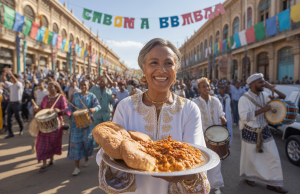Maha Saptami, falling on October 29, 2025, is a day of immense cultural and spiritual significance for millions of people celebrating Durga Puja. This auspicious day marks the penultimate phase of the Puja festivities, symbolizing the arrival of Goddess Durga on Earth to vanquish evil and restore peace.
Why is Maha Saptami Celebrated?
Maha Saptami is the seventh day of Navratri and a key part of the Durga Puja ritual. According to Hindu mythology, it commemorates the day when the Goddess began her battle against the demon Mahishasura, embodying the triumph of good over evil. Devotees believe that invoking the Goddess on this day brings blessings, strength, and prosperity.
The History and Significance of Maha Saptami
The celebration of Maha Saptami has its roots in ancient Hindu scriptures, particularly the Devi Mahatmya. On this day, the Kalparambha ritual is performed, followed by the Pran Pratishtha, where the idol of Goddess Durga is infused with life through sacred mantras and rituals. The day is also linked with the legend of King Suratha, who, along with a merchant named Samadhi, performed Durga Puja and was blessed by the Goddess.
One of the unique aspects of Maha Saptami is the “Nabapatrika Snan,” a ritual bathing of nine plants that represent the nine forms of Goddess Durga. These plants are tied together and worshipped as a symbol of nature’s divine power, highlighting the harmony between humans and the environment.
How is Maha Saptami Observed?
Across India, especially in West Bengal, Assam, Odisha, and Tripura, Maha Saptami is celebrated with vibrant rituals and cultural events. The day begins with devotees visiting pandals (decorated structures housing Durga idols) to offer prayers and seek blessings. The air resonates with the beats of dhak (traditional drums) and the chants of mantras.
Artistic performances, cultural dances, and traditional feasts add to the festive spirit. Bengalis indulge in delicious dishes like khichuri (a lentil-rice dish), labra (mixed vegetable curry), and an array of sweets. The evening aarti (ritual of light) is a mesmerizing sight, with lamps, incense, and conch shells creating an atmosphere of divinity.
Fun Facts about Maha Saptami
- The Nabapatrika ritual is also called Kolabou Puja because one of the plants, the banana tree, is draped in a sari and worshipped as a bride.
- Durga Puja is not just a religious festival but also a UNESCO Intangible Cultural Heritage of Humanity, showcasing its global cultural importance.
- In some regions, people organize processions where they carry the Nabapatrika to a river or pond for the ceremonial bath.
Join the Festivities!
Maha Saptami is more than just a day of rituals; it is a celebration of life, community, and the eternal triumph of good over evil. Whether you’re a believer or someone who loves experiencing diverse cultures, take part in the grandeur of Durga Puja this year. Visit a local pandal, taste the festive delicacies, and immerse yourself in the joyous spirit of Maha Saptami on October 29, 2025!









